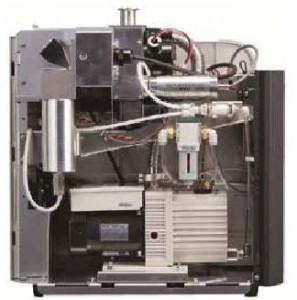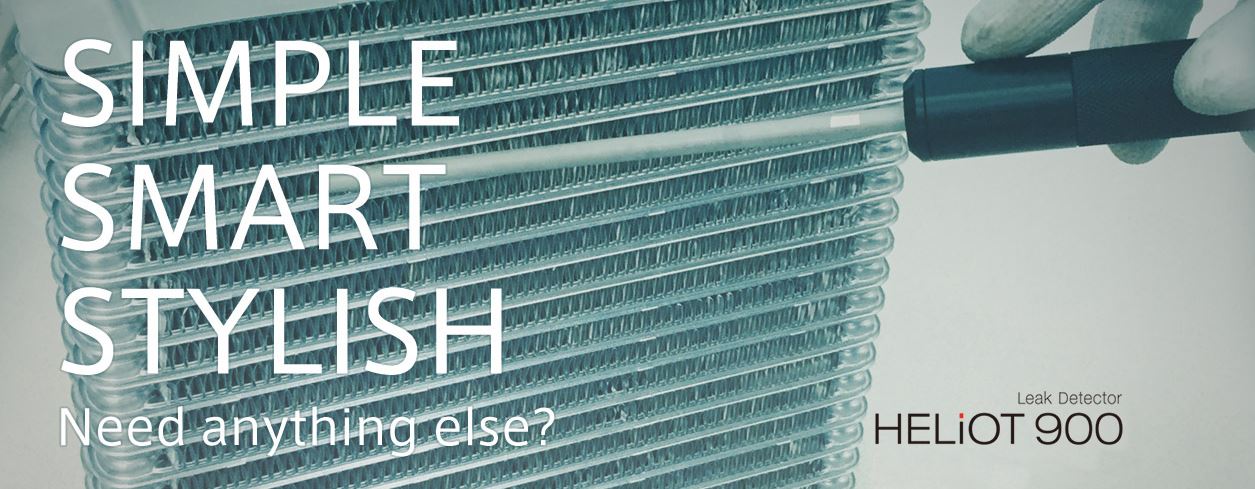This post is also available in: Japanese
*This article was released in “Technical Journal No.79 published in June, 2015”
3.6 Maintenance

HLDs use turbo molecular and fore pumps. It is necessary to periodically maintain those pumps and other parts, replace consumable goods, and recalibrate the calibrated leaks. The outer panels need to be removed in such cases and the panels of the “HELIOT 900 series” can be easily removed without using tools. Ion sources are replaceable units as before. The Pirani vacuum gauge heads and calibrated leaks are provided in easy-to-reach locations. The hose-shaped oil drain ports of W1 model rotary pumps make it easy to change the oil (Figure 7).
In addition, there are videos on the tablets that show how to maintain the units and replace consumable goods, so users can feel confident even when per forming maintenance or replacement for the first time. Users can set how long maintenance guide screens are displayed.
4.Conclusion
This paper is a report on the development of the “HELIOT 900 series” into which valuable customer requests and opinions have been incorporated. The environment surrounding leak tests using helium has been significantly changing for the past several years7).
Regarding Japanese standards, Japan Industrial Standard (JIS) Z 2330:1992 was entitled “Standard recommended guide for the selection of helium leak testing” and only covered leak tests using helium gas. However, the new JIS Z 2330:2012 standard is entitled “Non-destructive testing-Selection of leak testing methods” covering all leak tests.
With regard to certification of skills, the Japanese Society for Non-Destructive Inspection started certifying technicians’ skills in 2012 through a testing process. A factor behind this certification is that the accuracy of leak test results is significantly influenced by the skill levels of non-destructive inspection technicians. Thus, their skill levels need to be maintained at a certain level.
Helium gas used for leak tests is a ver y valuable resource since the atmosphere contains only a small amount of helium gas and the gas is produced in only limited areas. Therefore, it is necessary to use less helium gas and conserve it in the future.
Given such circumstances, we will continue improving and refining the basic performance and ease of use, improving the calibration technology, proposing optimum test methods and ways to reduce the amount of helium gas used, and we will make it possible to measure finer leaks more quickly and more accurately.
*This article was released in “Technical Journal No.79 published in June, 2015”
References
1) E. Ochiai, A. Umezawa: Japanese published examined application No. Hei 8-15708.
2) E. Ochiai: ULVAC TECHNICAL JOURNAL No.50 (1999) 19.
3) T. Maehira: ULVAC TECHNICAL JOURNAL No.74 (2011) 64.
4) ULVAC, Inc.: J. Vac. Soc. Jpn 54 (2011) 64.
5) T. Nakajima, T. Miyashita, Y. Nagata, M. Fukuhara, Y. Uchida, Y. Ohashi and T. Nishimaki: ULVAC TECHNICAL JOURNAL 76 (2012) 8.
6) T. Nakajima, R. Tanaka, T. Yuri, Y. Kurokawa, H. Aoyagi and N. Takahashi: ULVAC TECHNICAL JOURNAL 71 (2009) 14.
7) Y. Tamura: J. Vac. Soc. Jpn. 54 (2011) 56.
Michito HIRAYAMA*1, Norimasa SETO*1, Yujiro KUROKAWA*1, Toyoaki NAKAJIMA*1, Manabu KOTAKA*1, Toru OKUNO*2and Takeki NISHIMAKI*2
*1 Components Divison, ULVAC, Inc., 2500 Hagisono, Chigasaki, Kanagawa, 253-8543, Japan
*2 Research & Development Divison, ULVAC, Inc., 2500 Hagisono, Chigasaki, Kanagawa, 253-8543, Japan
The helium leak detector market is expanding from the vacuum, automobile, refrigeration, and nuclear power industries into the food and medical supply packing industry and other industries. Devices under test (DUT) and usage are also diversifying. Here we will introduce the“ HELIOT 900 series” that was developed in such a market environment with the aim of improving the basic performance (measuring smaller leaks more quickly) and ease of use.

